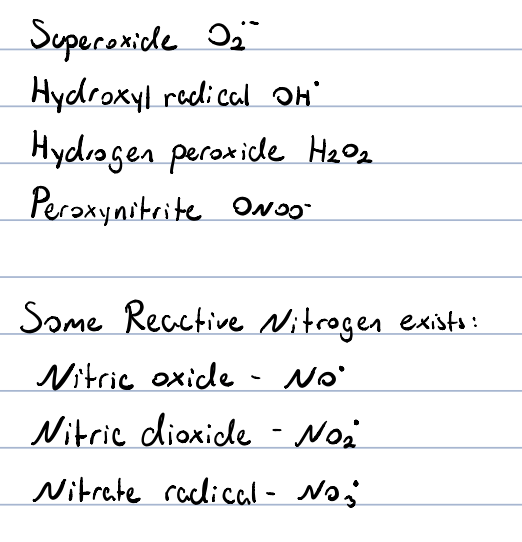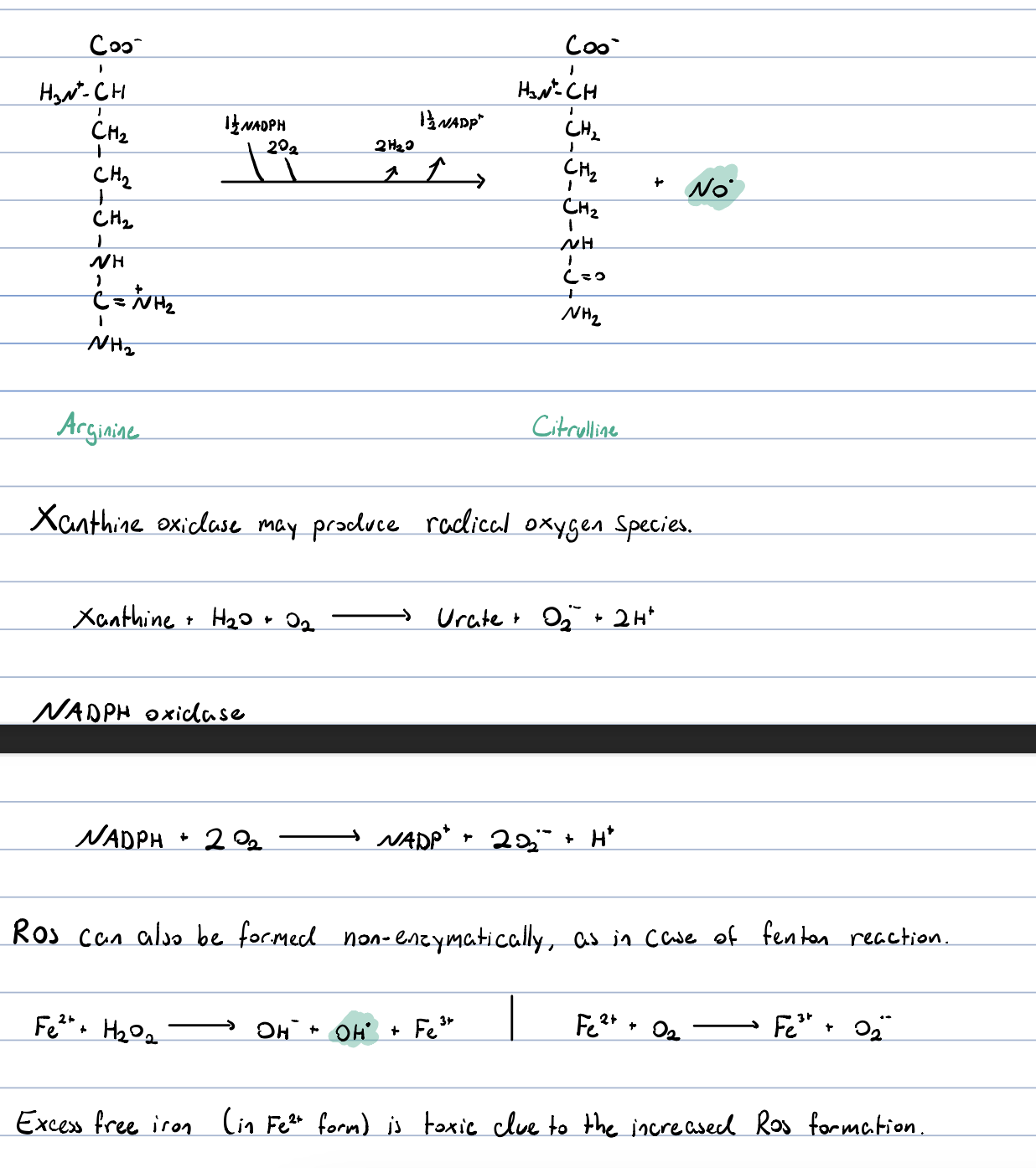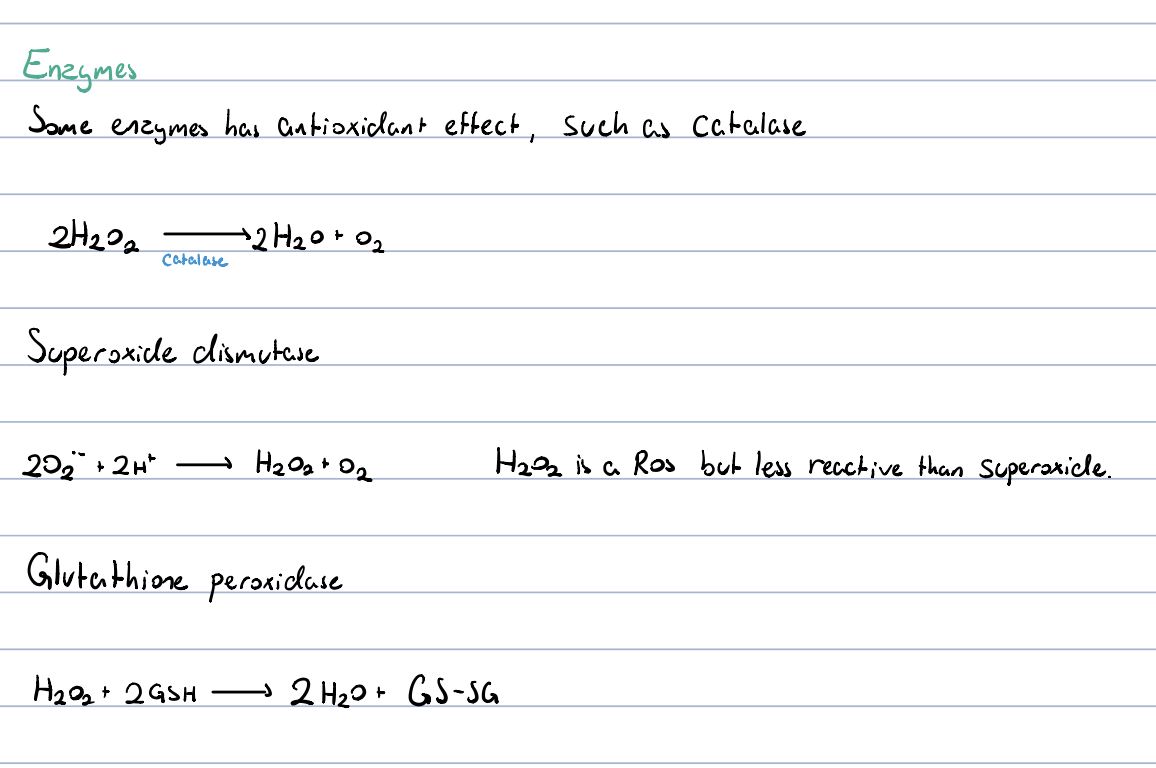19. The molecular sources of oxidative stress, signal transduction pathways induced by oxidative stress, molecular tools and protection against oxidative stress
0.0(0)
Card Sorting
1/11
There's no tags or description
Looks like no tags are added yet.
Study Analytics
Name | Mastery | Learn | Test | Matching | Spaced |
|---|
No study sessions yet.
12 Terms
1
New cards
what is oxidative stress?
oxidative stress is a phenomenon caused by an imbalance between production/accumulation of reactive oxygen species and the ability of the tissues to detoxify these reactive products
2
New cards
Reactive oxygen species?
free radicals contain unpaired, reactive free electrons
the free radicals are very reactive and are able to damage several biomolecules
some notable ROS are:
the free radicals are very reactive and are able to damage several biomolecules
some notable ROS are:

3
New cards
what is a radical?
a molecule/atom w. an unpaired valence electron
highly reactive
highly reactive
4
New cards
sources of reactive species?
the source of ROS and RNS may be endgenous or exogenous
examples of exogenous sources are exposure to pollutants, heavy metals, certain drugs, smoking and alcohol
the endogenous ROS are produced by both physiologically important enzymes and by non-enzymatic reactions
most notably, O2⁻⋅ can be formed in the reactions of the complex I and III in the respiratory chain. semiquinone (QH) is a radical and can easily pass an electron to O2 forming O2⁻⋅. so in this case the ROS is a by-product of the respiratory chain
another enzyme forming a radical is NO-synthase. this enzyme is present in macrophages, neurons and is endothelium. NOS catalyzes arginine to citrulline reaction by releasing nitric oxide
examples of exogenous sources are exposure to pollutants, heavy metals, certain drugs, smoking and alcohol
the endogenous ROS are produced by both physiologically important enzymes and by non-enzymatic reactions
most notably, O2⁻⋅ can be formed in the reactions of the complex I and III in the respiratory chain. semiquinone (QH) is a radical and can easily pass an electron to O2 forming O2⁻⋅. so in this case the ROS is a by-product of the respiratory chain
another enzyme forming a radical is NO-synthase. this enzyme is present in macrophages, neurons and is endothelium. NOS catalyzes arginine to citrulline reaction by releasing nitric oxide

5
New cards
oxidative damage to proteins?
aggregation, fragmentation, cleavage
reaction w. heme metal ion
modification of functional groups
→
change in ezymatic activity and ion transport
proteloysis
reaction w. heme metal ion
modification of functional groups
→
change in ezymatic activity and ion transport
proteloysis
6
New cards
oxidative damage to DNA?
disintegration of the sugar ring
base modification
strand breaks
→
mutation
failure during translation
inhibition of protein synthesis
base modification
strand breaks
→
mutation
failure during translation
inhibition of protein synthesis
7
New cards
oxidative damage to lipids?
saturation of unsaturated bonds
preparation of reactive metabolites
→
changes in membrane fluidity and permeability
the membrane proteins are involved
preparation of reactive metabolites
→
changes in membrane fluidity and permeability
the membrane proteins are involved
8
New cards
pathways induced by oxidative stress?
ROS can act. the NRF2 pathway. NRF2 is a TF which regulates expression of many genes related to protection of oxidative stress. in normal conditions NRF2 is bound to Keap1, which inhibits NRF2. Keap1 targets NRF2 for ubiquination and degradation
when there is oxidative stress, Keap1 will not inhibit NRF2 and it translocates to the nucleus. in the nucleus it forms heterodimers with maf proteins and binds to the ARE
the mechanism of release from Keap1 is by oxidation of Cys residues. upon binding of ARE it induces expression of oxidative stress protection, like gene for NADPH synthesis glutathione synthesis, or other genes for elimination of ROS
when there is oxidative stress, Keap1 will not inhibit NRF2 and it translocates to the nucleus. in the nucleus it forms heterodimers with maf proteins and binds to the ARE
the mechanism of release from Keap1 is by oxidation of Cys residues. upon binding of ARE it induces expression of oxidative stress protection, like gene for NADPH synthesis glutathione synthesis, or other genes for elimination of ROS
9
New cards
PARP?
poly-ADP-ribose polymerase is a protein involved in DNA repair in physiological conditions
in case of severe DNA damage, a lot of PAR is produced.
this will deplete the cell of both NAD+, which is the source of ADP-ribose and ATP
less NAD+ = less glucose oxidation
cellular death is the result of PARP overactivation
in case of severe DNA damage, a lot of PAR is produced.
this will deplete the cell of both NAD+, which is the source of ADP-ribose and ATP
less NAD+ = less glucose oxidation
cellular death is the result of PARP overactivation
10
New cards
ASK-1?
Apoptosis signal-regulating 1 is a MAPKKK (mitogen activated protein kinase kinase kinase)
when there is no oxidative stress it is bound to TRX and is an oxidative stress sensor
oxidative stress releases Trx and TRAF (TNF-⍺ receptor associated factor 2) binds and ASK-1 is activated
ASK-1 phosphorylate other MAPKK which phosphorylate JNK and p38 which leads to apoptosis
when there is no oxidative stress it is bound to TRX and is an oxidative stress sensor
oxidative stress releases Trx and TRAF (TNF-⍺ receptor associated factor 2) binds and ASK-1 is activated
ASK-1 phosphorylate other MAPKK which phosphorylate JNK and p38 which leads to apoptosis
11
New cards
NF-kβ?
ROS can also activate NF-kβ pathway
ROS activates IKKβ activates NF-kβ
NF-kβ will induce the transcription of many pro-inflammatory cytokines, like TNF⍺, IL-1, IL-6, COX and iNOS
ROS activates IKKβ activates NF-kβ
NF-kβ will induce the transcription of many pro-inflammatory cytokines, like TNF⍺, IL-1, IL-6, COX and iNOS
12
New cards
cellular defense against oxidative stress?
antioxidants
* compounds which functions to neutralize ROS
* they can do this by accepting or donating electrons to eliminate the unpaired condition of the free radical
* in this process they either directly react w. the radical and destroy it, or become new, more stable radicals
* e.g: glutathione, vitamin A, C and E, uric acid
enzymes
* image →
* compounds which functions to neutralize ROS
* they can do this by accepting or donating electrons to eliminate the unpaired condition of the free radical
* in this process they either directly react w. the radical and destroy it, or become new, more stable radicals
* e.g: glutathione, vitamin A, C and E, uric acid
enzymes
* image →
